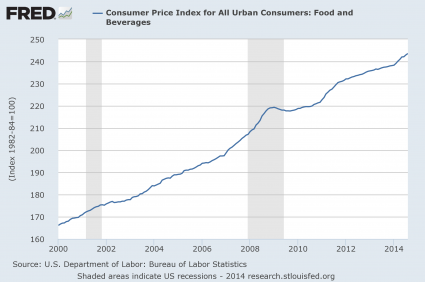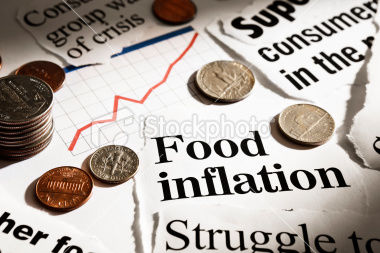The Federal Reserve wants you to either spend your money or to put it in the giant casino that we call the stock market. But when Americans spend their paychecks they are finding that they don't stretch as far as they once did. The cost of living continues to rise at a much faster pace than wages are rising, and this is especially true when it comes to the price of food.
Someone that I know wrote to me today and let me know that she had to shut down the food pantry that she had been running for the poor for so many years. It isn't that she didn't want to help the poor anymore. It was that she just couldn't deal with the rising food prices any longer. Now she is just doing the best that she can to survive herself.
Perhaps you have also noticed that food prices have gotten pretty crazy lately. In particular, meat prices have become absolutely obscene. For example, the average price of ground beef has risen to a new record high of over $4.09 a pound. Over the past twelve months, that works out to a whopping 17 percent increase...
The average price for a pound of ground beef climbed to another record high - $4.096 per pound - in the United States in September, according to data released today by the Bureau of Labor Statistics (BLS).
In August, according to BLS, the average price for a pound of all types of ground beef topped $4 for the first time - hitting $4.013. In September, the average price jumped .083 cents, an increase of 2.1 percent in one month.
A year ago, in September 2013, the average price for a pound of ground beef was $3.502 per pound. Since then, it has climbed 59.4 cents - or about 17 percent in one year.The "intellectuals" over at the Federal Reserve insist that "a little bit of inflation" is good for an economy, but the truth is that inflation slowly robs us of our buying power.
In a previous article, I shared a chart that showed how food inflation has risen dramatically since the year 2000. For this article, I wanted to show how food inflation has risen since the 1970s. As you can see, the rise in food prices has been absolutely relentless for more than 40 years...

But they aren't.
In fact, CNN is reporting that our paychecks have fallen back to 1995 levels...
Americans also don't feel any better off. While more people may have jobs, they aren't bringing home fatter paychecks. Wages and income have remained stagnant for years, making it tough for folks even though inflation is low. Median household income, which stood at $51,939 last year, is back to 1995 levels.
Consumers expect a median income boost of 1.1% over the next year, Curtin said. But that won't keep up with their inflation expectations of 2.8%.
"American households, on average, are still struggling with their living standards slowly eroding," he said.This is one of the primary reasons why the middle class is disappearing in America.
The purchasing power of our dollars is continually diminishing.
And this could be just the beginning. Right now, severe drought is affecting some of the most important agricultural areas around the globe. Most people are aware of the nightmarish drought in California, but did you know that things in Brazil are even worse? Brazil is one of the most important food exporters in the world, and so they definitely need our prayers.
In addition, a "black swan event" such as a worldwide explosion of the Ebola pandemic could quickly drive food prices into the stratosphere.
Just this week, we learned that food prices in the Ebola-stricken regions of Liberia, Guinea and Sierra Leone have already risen by an average of 24 percent...
Infection rates in the food-producing zones of Kenema and Kailahun in Sierra Leone, Lofa and Bong County in Liberia and GuDeckDedou in Guinea are among the highest in the region. Hundreds of farmers have died.
The three governments quarantined districts and restricted movements to contain the virus' spread. But those measures also disrupted markets and led to food scarcity and panic buying, further pushing up prices, WFP and the Food and Agriculture Organization have said.
"Prices have risen by an average of 24 percent," said WFP spokeswoman Elisabeth Byrs, adding an assessment of major markets showed the price of basic commodities was rising in Guinea, Liberia and Sierra Leone and in neighboring Senegal.If you have been storing up food, I think that you will be very happy with your decision in the long run.
Without a doubt, food prices are only going to be going up from here.
But the Federal Reserve continues to insist that inflation is under control.
One of the ways that they make the "official numbers" look good is by playing accounting games. They regularly change the way that inflation is calculated in order keep everyone calm.
You don't have to take my word for it. Posted below is an excerpt from an article by Mike Bryan, a vice president and senior economist in the Atlanta Fed's research department...
The Economist retells a conversation with Stephen Roach, who in the 1970s worked for the Federal Reserve under Chairman Arthur Burns. Roach remembers that when oil prices surged around 1973, Burns asked Federal Reserve Board economists to strip those prices out of the CPI "to get a less distorted measure. When food prices then rose sharply, they stripped those out too - followed by used cars, children's toys, jewellery, housing and so on, until around half of the CPI basket was excluded because it was supposedly 'distorted'" by forces outside the control of the central bank. The story goes on to say that, at least in part because of these actions, the Fed failed to spot the breadth of the inflationary threat of the 1970s.
I have a similar story. I remember a morning in 1991 at a meeting of the Federal Reserve Bank of Cleveland's board of directors. I was welcomed to the lectern with, "Now it's time to see what Mike is going to throw out of the CPI this month." It was an uncomfortable moment for me that had a lasting influence. It was my motivation for constructing the Cleveland Fed's median CPI.
I am a reasonably skilled reader of a monthly CPI release. And since I approached each monthly report with a pretty clear idea of what the actual rate of inflation was, it was always pretty easy for me to look across the items in the CPI market basket and identify any offending - or "distorted" - price change. Stripping these items from the price statistic revealed the truth - and confirmed that I was right all along about the actual rate of inflation.It is all a game to them.
It is all about getting to the "right number" to release to the public.
But anyone that goes to the grocery store knows what has been happening to food prices.
The next time you get to the checkout register and you feel tempted to ask the cashier what organ you should donate to pay for your groceries, please keep in mind that it is not the fault of the cashier.
Instead, there is one entity that you should blame.
Blame the Federal Reserve - their policies are slowly pushing the middle class into oblivion.




Comment: Things aren't likely to improve anytime soon, and in fact, could probably get much worse as recent indicators show the US economy is headed for a crisis. Storing food would be a wise thing to do:
A good way to invest your money: Store large amounts of food, like now